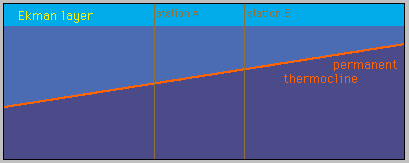

The Sverdrup relation describes the balance between energy input into the subtropical ocean from the wind stress and energy removal into the western boundary currents through the Rossby wave mechanism. (Rossby wave propagation is the subject of Exercise 5.)
 |

|
In the subtropical gyres of the oceans the curl of the wind stress produces a convergence of mass in the Ekman layer which leads to Ekman pumping, i.e. a downward directed vertical velocity w at the bottom of the Ekman layer. On its own this depresses the permanent thermocline. The process is demonstrated when you press the button in the lower left frame.
The position of the thermocline is restored through westward movement of the sloping thermocline, a consequence of the Rossby wave mechanism which moves all irregularities in the shape of the thermocline (including all departures from a horizontal orientation of the thermocline) into the western boundary currents. The westward movement of the permanent thermocline is demonstrated when you press the button in the lower right frame.
Note that when this westward movement is observed at a fixed location (for example at stations A or B) it is equivalent to upward motion of the thermocline.